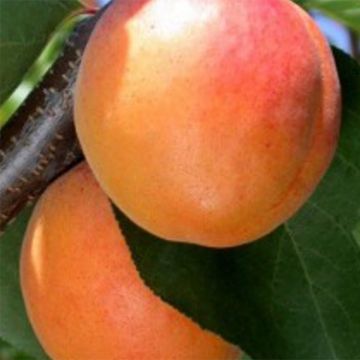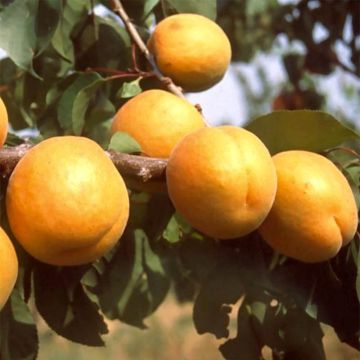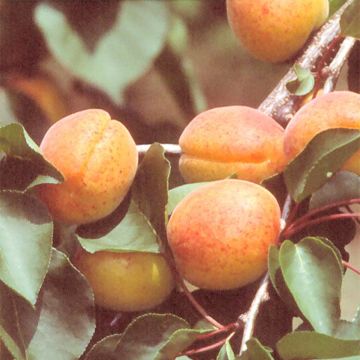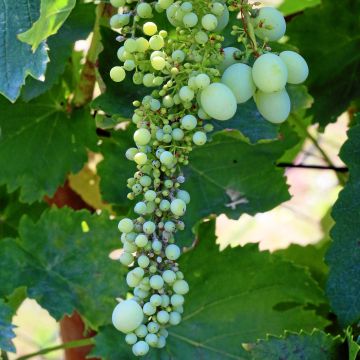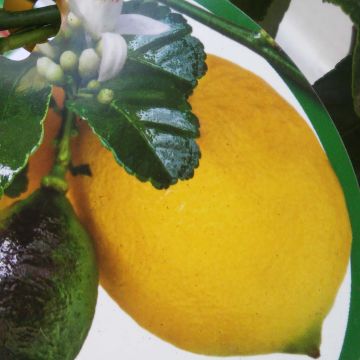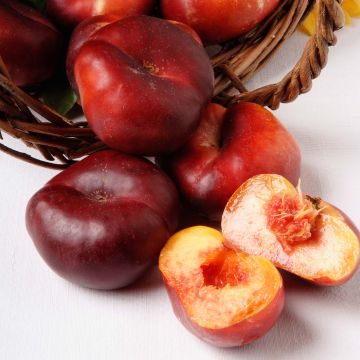

Abricotier Rouge du Roussillon Bio en racines nues, forme scion
Prunus armeniaca Organic Rouge du Roussillon - Apricot Tree
Prunus armeniaca Rouge du Roussillon
Apricot
Apricot tree arrived in good condition. Just need to plant it and wait.
Marie, 27/02/2024
This item cannot be shipped to the selected country
Oversize package delivery charge from €6.90
Delivery to Corse prohibited
More information
Schedule delivery date,
and select date in basket
This plant carries a 6 months recovery warranty
More information
We guarantee the quality of our plants for a full growing cycle, and will replace at our expense any plant that fails to recover under normal climatic and planting conditions.
Oversize package: home delivery by special carrier from €6.90 per order..
Express home delivery from €8.90.
Delivery to Corse prohibited: UE law prohibits the import of this plant from mainland France to Corse as part of the fight against Xylella fastidiosa. Please accept our sincere apologies.
More information

Description
The Organic 'Rouge du Roussillon' Apricot Tree, from Organic Farming, is a famous semi-late flowering variety widely planted in orchards in the south of France. It is self-fertile, vigorous and highly productive. Its fruit is renowned for its unique and pronounced aroma. It is medium-sized, about 5cm (2in) in diameter, round with slight asymmetry. The flesh is orange, firm and melting, sweet and fragrant. Its pasty consistency makes it ideal for jams, compotes or fruit tarts. It should be planted in autumn for a harvest starting from mid-July.
The apricot tree, Prunus armeniaca in Latin, is native to Central and Eastern Asia. It has been cultivated in China for 3,000 years before Christ. The apricot tree we cultivate was introduced to the Mediterranean basin from Armenia, hence its name, at the beginning of the Christian era. Its introduction to France took place during the Renaissance. In 1830, in the Pyrénées-Orientales, a chance seedling gave rise to the 'Rouge du Roussillon' variety. This variety obtained a Protected Designation of Origin (PDO) in 2016.
Despite its semi-late flowering, which protects it from late winter frosts, the 'Rouge du Roussillon' Apricot Tree is mainly adapted to the south of France. A sunny and warm location, protected from winds and facing south, will improve fruiting. This variety has a semi-erect and semi-spreading habit, indicating a slender tree with a tall base that then spreads out. The foliage is spaced out and some branches have vertical growth, while others have horizontal growth. The leaves are dentate, heart-shaped, and have long petioles. It can reach up to 4m (13ft) in height with a diameter of 3m (10ft). It starts producing at 3 years and reaches full maturity at 7 years. The apricot tree blooms in late March, before the leaves appear. The flowering is carried by the previous year's branches. The flower has 5 pink petals and purple sepals. It is fragrant but lasts only a short time. Fruit ripening occurs from mid-July for about two weeks.
The 'Rouge du Roussillon' Apricot Tree is self-fertile. It does not require the presence of another apricot tree for pollination.
Apricots are consumed fresh, dried, or prepared in various ways: jams, tarts, compotes, apricots in syrup, gratins, clafoutis... They are also used in savoury dishes, such as rabbit with apricots and parsnips (an English recipe). Apricot juices are often mixed with a touch of peach juice to balance the natural acidity of the apricot.
For transportation reasons, our tallest scions may be pruned before shipment. They are suitable for all common training sizes: cordons, espaliers, goblets, half-standards, and low standards, except for high standards. If you would like more information or advice on the training of your fruit trees, please do not hesitate to contact us.
Report an error about the product description
Prunus armeniaca Organic Rouge du Roussillon - Apricot Tree in pictures


Plant habit
Fruit
Flowering
Foliage
Botanical data
Prunus
armeniaca
Rouge du Roussillon
Rosaceae
Apricot
Cultivar or hybrid
Other Apricot trees
Planting and care
Planting preferably takes place at the beginning of winter, when the tree is in vegetative rest, and before frost. To plant several apricot trees, space them at least 1.5m (5ft) apart. Dig a hole two to three weeks before planting, twice as wide and deep as the pot. On the chosen day, place the tree with its pot in a basin of water, in order to moisten the entire root ball through capillary action. Place compost at the bottom of the hole. Install the tree in the hole, fill with soil mixed with compost. Firmly tamp down at the base. The root ball should be completely covered. Water generously.
The 'Rouge du Roussillon' Apricot Tree is not very demanding when it comes to soil type. It will ideally thrive in a rich and light, fresh, and above all well-drained soil: it does not tolerate stagnant water. Plant it in a sunny and warm location, sheltered from the North and East winds.
Planting period
Intended location
Care
-
, onOrder confirmed
Reply from on Promesse de fleurs
Mediterranean fruit trees
Haven't found what you were looking for?
Hardiness is the lowest winter temperature a plant can endure without suffering serious damage or even dying. However, hardiness is affected by location (a sheltered area, such as a patio), protection (winter cover) and soil type (hardiness is improved by well-drained soil).

Photo Sharing Terms & Conditions
In order to encourage gardeners to interact and share their experiences, Promesse de fleurs offers various media enabling content to be uploaded onto its Site - in particular via the ‘Photo sharing’ module.
The User agrees to refrain from:
- Posting any content that is illegal, prejudicial, insulting, racist, inciteful to hatred, revisionist, contrary to public decency, that infringes on privacy or on the privacy rights of third parties, in particular the publicity rights of persons and goods, intellectual property rights, or the right to privacy.
- Submitting content on behalf of a third party;
- Impersonate the identity of a third party and/or publish any personal information about a third party;
In general, the User undertakes to refrain from any unethical behaviour.
All Content (in particular text, comments, files, images, photos, videos, creative works, etc.), which may be subject to property or intellectual property rights, image or other private rights, shall remain the property of the User, subject to the limited rights granted by the terms of the licence granted by Promesse de fleurs as stated below. Users are at liberty to publish or not to publish such Content on the Site, notably via the ‘Photo Sharing’ facility, and accept that this Content shall be made public and freely accessible, notably on the Internet.
Users further acknowledge, undertake to have ,and guarantee that they hold all necessary rights and permissions to publish such material on the Site, in particular with regard to the legislation in force pertaining to any privacy, property, intellectual property, image, or contractual rights, or rights of any other nature. By publishing such Content on the Site, Users acknowledge accepting full liability as publishers of the Content within the meaning of the law, and grant Promesse de fleurs, free of charge, an inclusive, worldwide licence for the said Content for the entire duration of its publication, including all reproduction, representation, up/downloading, displaying, performing, transmission, and storage rights.
Users also grant permission for their name to be linked to the Content and accept that this link may not always be made available.
By engaging in posting material, Users consent to their Content becoming automatically accessible on the Internet, in particular on other sites and/or blogs and/or web pages of the Promesse de fleurs site, including in particular social pages and the Promesse de fleurs catalogue.
Users may secure the removal of entrusted content free of charge by issuing a simple request via our contact form.
The flowering period indicated on our website applies to countries and regions located in USDA zone 8 (France, the United Kingdom, Ireland, the Netherlands, etc.)
It will vary according to where you live:
- In zones 9 to 10 (Italy, Spain, Greece, etc.), flowering will occur about 2 to 4 weeks earlier.
- In zones 6 to 7 (Germany, Poland, Slovenia, and lower mountainous regions), flowering will be delayed by 2 to 3 weeks.
- In zone 5 (Central Europe, Scandinavia), blooming will be delayed by 3 to 5 weeks.
In temperate climates, pruning of spring-flowering shrubs (forsythia, spireas, etc.) should be done just after flowering.
Pruning of summer-flowering shrubs (Indian Lilac, Perovskia, etc.) can be done in winter or spring.
In cold regions as well as with frost-sensitive plants, avoid pruning too early when severe frosts may still occur.
The planting period indicated on our website applies to countries and regions located in USDA zone 8 (France, United Kingdom, Ireland, Netherlands).
It will vary according to where you live:
- In Mediterranean zones (Marseille, Madrid, Milan, etc.), autumn and winter are the best planting periods.
- In continental zones (Strasbourg, Munich, Vienna, etc.), delay planting by 2 to 3 weeks in spring and bring it forward by 2 to 4 weeks in autumn.
- In mountainous regions (the Alps, Pyrenees, Carpathians, etc.), it is best to plant in late spring (May-June) or late summer (August-September).
The harvesting period indicated on our website applies to countries and regions in USDA zone 8 (France, England, Ireland, the Netherlands).
In colder areas (Scandinavia, Poland, Austria...) fruit and vegetable harvests are likely to be delayed by 3-4 weeks.
In warmer areas (Italy, Spain, Greece, etc.), harvesting will probably take place earlier, depending on weather conditions.
The sowing periods indicated on our website apply to countries and regions within USDA Zone 8 (France, UK, Ireland, Netherlands).
In colder areas (Scandinavia, Poland, Austria...), delay any outdoor sowing by 3-4 weeks, or sow under glass.
In warmer climes (Italy, Spain, Greece, etc.), bring outdoor sowing forward by a few weeks.



































